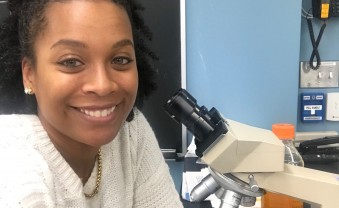
New Course Blends Science and African American History
Simara Price, an assistant professor of biology, is teaching Biology and the African Diaspora in America, which takes a biological and historical look at topics including skin pigmentation, human evolution and the influence biology has had on the concept of race.
Its structure was inspired by the format of an African American art history course that Price took as an undergraduate at the University of Maryland. The class took a chronological look at the artwork, leading Price to learn about both the art and how the black experience during that time influenced the art rather than just by examining the subject.
“I always loved that aspect of that course, my professor could have found different ways to put these pieces together but I loved that it was chronological,” Price says.
According to Price, it is unusual to teach the sciences chronologically as they are often grouped by specific topics rather than by time. Price thought that this would be a great opportunity to teach a course using this unique format.
“What I wanted to do was use the chronology for the students to relate how science during those different time periods created the atmosphere that black Americans or people in the African diaspora now are experiencing in life,” she says.
After taking a scientific look at the biology behind different skin pigmentation, Price and her students explore where the concept of race originated and touched on many of the ideas that various groups throughout history took on race. From religious origin theories to misconceptions of pain perception, the course takes a historical look at the long-lasting impact of the racism and blatant mistreatment of black individuals due to their skin pigmentation.
A prominent focus of the course is the historical significance of scientific racism like that expressed by renowned scientists like Carl von Linné, the father of modern taxonomy; Samuel Morton, who categorized humans based on the size of their skulls; and James Watson, who was widely credited alongside his partner for the discovery of the DNA double helix structure. The course includes a field trip to see Morton’s Cranial Collection as part of a lecture at the Penn Museum.
Price also plans to dedicate several class periods to the incredible story of Henrietta Lacks, an African American woman whose cancer cells were used to create the first immortalized cell line without her knowledge or consent. While her cells are still used today for medical research, it still brings up many questions of the ethics of the situation.
One of Price’s goals is to make the course accessible and available to all students, regardless of major or class year. While the class is a biology course with lab time, it does not count as a credit towards a biology major. The students taking the class range from politics to economics majors.
Price hopes to foster discussions from a diverse group of standpoints. “I didn’t want my course to be closed out to sophomores and freshmen,” she shares, “Everyone has an interesting contribution to the conversation. I wanted to make sure that there was a different mix of people with different experiences who were able to participate.”
“I think some of the conversations that we’re having can help these students with their insight as they move through college. Maybe it can even help spark their thought process on what they want to do in their career by expanding their world,” she explains, “I’m really excited to have created an opportunity for students to learn biology in a way that isn’t scary to them.” —By Mary Lobo ’15
